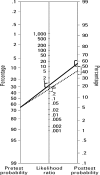PGS-FISH in reproductive medicine and perspective directions for improvement: a systematic review
- PMID: 21713549
- PMCID: PMC3170114
- DOI: 10.1007/s10815-011-9578-9
PGS-FISH in reproductive medicine and perspective directions for improvement: a systematic review
Abstract
Introduction: Embryo selection can be carried out via morphological criteria or by using genetic studies based on Preimplantation Genetic Screening. In the present study, we evaluate the clinical validity of Preimplantation Genetic Screening with fluorescence in situ hybridization (PGS-FISH) compared with morphological embryo criteria.
Material and methods: A systematic review was made of the bibliography, with the following goals: firstly, to determine the prevalence of embryo chromosome alteration in clinical situations in which the PGS-FISH technique has been used; secondly, to calculate the statistics of diagnostic efficiency (negative Likelihood Ratio), using 2 × 2 tables, derived from PGS-FISH. The results obtained were compared with those obtained from embryo morphology. We calculated the probability of transferring at least one chromosome-normal embryo when it was selected using either morphological criteria or PGS-FISH, and considered what diagnostic performance should be expected of an embryo selection test with respect to achieving greater clinical validity than that obtained from embryo morphology.
Results: After an embryo morphology selection that produced a negative result (normal morphology), the likelihood of embryo aneuploidies was found to range from a pre-test value of 65% (prevalence of embryo chromosome alteration registered in all the study groups) to a post-test value of 55% (Confidence interval: 50-61), while after PGS-FISH with a negative result (euploid), the post-test probability was 42% (Confidence interval: 35-49) (p < 0.05). The probability of transferring at least one euploid embryo was the same whether 3 embryos were selected according to morphological criteria or whether 2, selected by PGS-FISH, were transferred. Any embryo selection test, if it is to provide greater clinical validity than embryo morphology, must present a LR-value of 0.40 (Confidence interval: 0.32-0.51) in single embryo transfer, and 0.06 (CI: 0.05-0.07) in double embryo transfer.
Discussion: With currently available technology, and taking into account the number of embryos to be transferred, the clinical validity of PGS-FISH, although superior to that of morphological criteria, does not appear to be clinically relevant.
Figures


References
Publication types
MeSH terms
LinkOut - more resources
Full Text Sources

